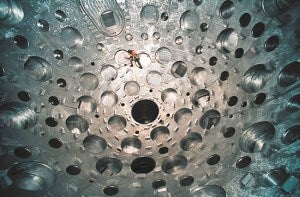World, meet the National Ignition Facility: a massive and incredible research device to study (and create) controlled nuclear fusion. Containing the world’s largest and highest-energy laser, the facility hopes to create the first controlled thermonuclear reaction ever. If they succeed, they will have achieved a dream of physics that many claimed impossible: man-made fusion as a source of energy. A mini star. Happy Friday.

Today marks the opening ceremony, with big names like Energy Secretary Steven Chu, laser pioneer Charles Hunt Townes, and even the Governator in attendance. Housed at the infamous Lawrence Livermore National Laboratory in California, the NIF was 12 years and 3.5 billion dollars in the making. The facility covers three football fields, ten stories, and contains sixty miles of mirrors, fiber optics, crystals and light amplifiers. Funded by the Department of Energy, the NIF hopes to begin experiments next year.
So how does one go about creating a mini star? The NIF uses 192 high powered lasers, capable of delivering a two million joules of ultraviolet energy. From their source, the lasers travel over 1,000 feet through a series of amplifiers, exponentially increasing their power before they reach their destination: the spherical “target chamber.” Here, each laser in the room is pointed at a single drop of hydrogen fuel about the size of a BB pellet. By blasting the hydrogen with extreme heat simultaneously from all sides, the lasers will fuse the hydrogen together to form helium, a reaction that releases a whole lot of energy.
If a fusion reaction can produce enough energy to fuel itself (i.e. start a chain reaction), it has reached the point of ignition. The only man-made fusion reactions that have ever achieved ignition were anything but controlled; they were hydrogen bombs. For over fifty years, physicists have argued about whether or not fusion energy could ever be harnessed without blowing up in your face. The NIF is built to solve that question.
Check out a video about the new facility:
Will it work? No one is really sure. The facility can’t make enough energy for ignition yet, and might not ever be able to. To critics, this makes the NIF a massive (and expensive) gamble. Running the lab will cost about $140 million per year, which doesn’t even touch the 3.5 billion already invested. The construction process was rife with delays, setbacks, and budget increases (the project was initially priced at $1 billion). It will still take years of experimentation before the facility produces any real results, and the possibility of ignition is still a big, fat maybe.

The applications of this research are unbelievably diverse. Besides the ultimate goal of creating an energy source, the facility will be used to study how nuclear fusion takes place within both stars and at the core of planets. Our mini star could also provide some hints as to what happened around the time of the Big Bang, a tricky theory to test out in the lab. The NIF will also be used to national security ends, running simulations on the status of our aging nuclear arsenal. This is especially important given the nuclear testing moratorium established in 1992, making live bomb testing a no-no.
If the project succeeds, it could create a renewable, carbon-free energy source of unimaginable value. To its critics, it’s an expensive wet dream of physicists that will never live up to its costs. To repeat the classic refrain of speculative science, time will tell. Personally, as a Bay Area resident, I’m pretty excited about the idea of having a small star burning about 30 miles from my house. Let’s just hope they earthquake-proofed the thing.


